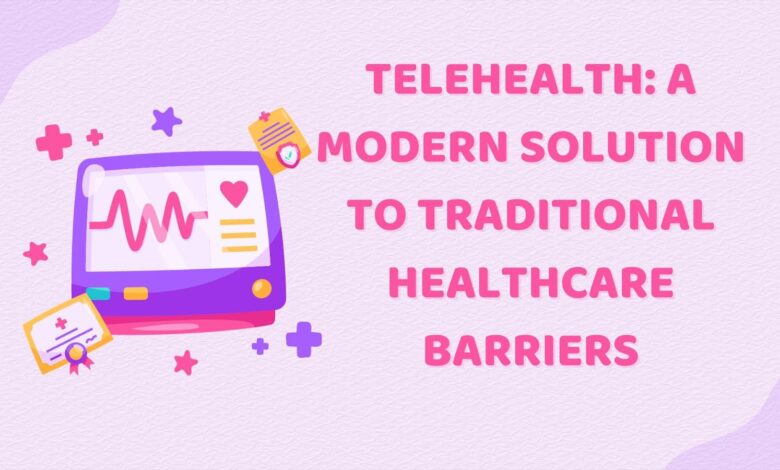Telehealth: A Modern Solution to Traditional Healthcare Barriers

New technology has changed how almost everything is done, including healthcare. People can now see doctors without going to the office. This is called telehealth. It uses computers, phones, and devices to let patients talk to doctors from home.
This helps people who cannot easily get to the doctor’s office. Some people live too far away or have trouble getting around. In some areas, there are not enough doctors nearby. These are called healthcare deserts. It is hard for people there to get medical care.
But with telehealth, the distance does not matter. Patients can see and talk to doctors using video chat. Doctors can look at patients’ health data from devices at home. They can track chronic illnesses like diabetes. Patients can get care and advice without the trouble of traveling. Telehealth is getting better all the time too.
New tools and systems are making it easier to share health information. More doctors are offering video visits. Hospitals have apps to help patients manage their health. As telehealth improves, patients have an easier time getting the care they need. Problems like distance and mobility are not barriers anymore. Telehealth is changing healthcare to make it work better for everyone.
Overcoming Distance and Access Barriers with Virtual Care
One of the biggest obstacles facing patients, especially those in rural areas, is distance from providers. With telehealth, patients can conveniently access care through:
- Video visits: Video visits, powered by the best practice management software for therapists, enable patients to connect with providers through real-time video chat with no travel. This makes care easier to get. It also saves time and money.
- Remote monitoring: Patients can wear special devices. They can use tools at home that let doctors see their vital signs. Doctors can check things like heart rate without seeing patients in person. This facilitates care for chronic conditions.
- Messaging: Patients can connect with doctors through websites, texting, and email. They can get advice, refills of medicine, and referrals to specialists.
A 2022 study found that 89% of patients were satisfied with telehealth for convenience and 70% felt access improved. Telehealth lifts geographic barriers to increase healthcare reach.
Overcoming Mobility Barriers through At-Home Care Solutions
For patients who have trouble moving due to their age, disability, or sickness, going to appointments can be very hard or impossible. Telehealth allows patients to meet providers from the comfort of home through:
- At-home diagnosis like Teladoc’s house call service using video exams and remote tools.
- Physical/occupational therapy via video using at-home exercises and virtual supervision.
- Remote patient monitoring for chronic issues like hypertension, diabetes, post-surgery care, etc.
Telehealth home solutions give mobility-limited patients access without the burden of commutes. A 2022 AARP study found 92% of seniors believe telehealth improved their quality of life.
According to a study by the Journal of Medical Internet Research, the top telehealth services improving mobility access for elderly and disabled patients are:
Source: ncbi.nlm.nih.gov
Smoothing Access Inequities in Healthcare Deserts
Many underserved communities do not have enough nearby doctors. This is a problem made worse by economic disadvantages. Telehealth helps bridge these access gaps by:
- Offering affordable virtual care options. With lower overhead doctors can reduce costs.
- Connecting rural and urban community health centers through telehealth partnerships.
- Utilizing online prescription and medication delivery removes transportation barriers.
- Using mobile health clinics with telehealth can bring medical care directly to neighborhoods in need.
Studies show telehealth improves health and saves 20-60% on costs in rural areas – The National Rural Health Association.
Current Telehealth Regulatory Landscape
The pandemic accelerated telehealth adoption, prompting regulatory changes to improve access. However, limitations remain including:
- Restrictive policies on eligible sites and services for telehealth in many states.
- Licensure requirements preventing cross-state telehealth.
- Narrow coverage of virtual services and remote monitoring by insurers.
- Broadband gaps in rural areas restrict access.
But things are changing with new bills in Congress to make telehealth rules better and improve access. Keeping up advocacy is key for permanent policies helping vulnerable populations.
Evolution of Telehealth Technology and Tools
Telehealth capabilities are rapidly evolving allowing providers to deliver broader care virtually including:
- Wearable sensors and at-home medical devices for remote monitoring.
- Smartphone apps and patient portals provide care management.
- Virtual/augmented reality simulations for behavioral health therapy.
- AI triage chatbots, personalized education apps, and medication adherence tools.
- Integration of telehealth with EHR and other systems.
As telehealth tech advances, so do the care possibilities. Using advanced tools can get more people to care. It can manage community health, empower patients in decisions, and improve results.
Telehealth Benefits and Limitations
| Benefits | Limitations |
| Expanded access to care | Technical/usability issues |
| Convenience and time savings | Narrower scope of care for some services |
| Lower costs and improved outcomes | Privacy and security concerns |
| Addresses healthcare disparities | Limitations based on digital literacy |
| Flexibility and continuity of care | Reimbursement restrictions |
Telehealth has downsides to think about. However, the potential benefits outweigh them when applied thoughtfully. With careful planning and responsible policies, providers can maximize telehealth benefits.
The Future Is Virtual: Telehealth Removes Barriers for Modern Healthcare
New types of online and video care are getting rid of old healthcare problems. This includes distance to doctors, trouble getting around, and lack of services for certain groups.
Wider use of telehealth with supportive policies and new innovations will shape the future of healthcare.
As we advance, the focus should be on improving health for all people by making care accessible in any life situation or place. The possibilities of telehealth are just starting.
Frequently Asked Questions
Is telehealth covered by health insurance?
Coverage expanded during COVID-19 but still varies. Medicare covers many services like video visits and remote monitoring. Medicaid programs differ by state. Private insurers are expanding telehealth benefits.
What kind of care limitations exist with telehealth?
Hands-on exams and procedures can only be done in person. Complex care like surgery or intensive treatments requires in-clinic care. But telehealth can complement and expand in-person care.
What are some telehealth best practices for providers?
Update workflows, train staff on virtual care, and integrate telehealth with EHR/data systems. Ensure appropriate care settings and follow-up. Enable patient transitions between virtual and in-person care settings.
Conclusion
Telehealth is getting rid of old barriers so more people can have good, fair medical care. There are still some limits though. But the benefits are bigger if telehealth is used carefully.
New tools for telehealth are always coming out.
They make it easier to see the doctor from home. Tools like special devices to check your blood pressure or blood sugar at home. Or websites where you can message your doctor. Or apps that remind you to take your medicine. These new tools give patients and doctors more ways to connect.
There also needs to be fair rules for telehealth. The rules should help patients use telehealth easily. And they should make sure underserved communities can access care. With good rules, telehealth can help lessen unfair differences in healthcare.
When new tools are used wisely and fair policies support telehealth, it can really change healthcare. Telehealth makes care more available to all people no matter where they live or how mobile they are. It lets patients take charge of their health.
Barriers like distance and mobility are much lower with telehealth. Healthcare works better for more Americans with telehealth. The limits are still there but the benefits are bigger. Telehealth unlocks new possibilities for patients to access quality, affordable care.



